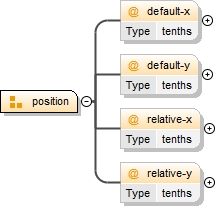<xs:attributeGroup name="position">
<xs:annotation>
<xs:documentation>The position attributes are based on MuseData print suggestions. For most elements, any program will compute a default x and y position. The position attributes let this be changed two ways. The default-x and default-y attributes change the computation of the default position. For most elements, the origin is changed relative to the left-hand side of the note or the musical position within the bar (x) and the top line of the staff (y). For the following elements, the default-x value changes the origin relative to the start of the current measure: - note - figured-bass - harmony - link - directive - measure-numbering - all descendants of the part-list element - all children of the direction-type element When the part-name and part-abbreviation elements are used in the print element, the default-x value changes the origin relative to the start of the first measure on the system. These values are used when the current measure or a succeeding measure starts a new system. For the note, figured-bass, and harmony elements, the default-x value is considered to have adjusted the musical position within the bar for its descendant elements. Since the credit-words and credit-image elements are not related to a measure, in these cases the default-x and default-y attributes adjust the origin relative to the bottom left-hand corner of the specified page. The relative-x and relative-y attributes change the position relative to the default position, either as computed by the individual program, or as overridden by the default-x and default-y attributes. Positive x is right, negative x is left; positive y is up, negative y is down. All units are in tenths of interline space. For stems, positive relative-y lengthens a stem while negative relative-y shortens it. The default-x and default-y position attributes provide higher-resolution positioning data than related features such as the placement attribute and the offset element. Applications reading a MusicXML file that can understand both features should generally rely on the default-x and default-y attributes for their greater accuracy. For the relative-x and relative-y attributes, the offset element, placement attribute, and directive attribute provide context for the relative position information, so the two features should be interpreted together. As elsewhere in the MusicXML format, tenths are the global tenths defined by the scaling element, not the local tenths of a staff resized by the staff-size element.</xs:documentation>
</xs:annotation>
<xs:attribute name="default-x" type="tenths"/>
<xs:attribute name="default-y" type="tenths"/>
<xs:attribute name="relative-x" type="tenths"/>
<xs:attribute name="relative-y" type="tenths"/>
</xs:attributeGroup> |
